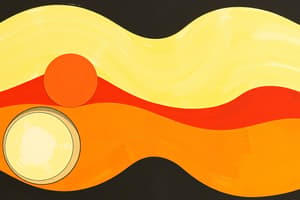Podcast
Questions and Answers
What is the primary function of a line in art, and what are some examples of different types of lines?
What is the primary function of a line in art, and what are some examples of different types of lines?
A line is a path created by a moving point, mark or object. Examples of lines include straight, swirly, wavy, jagged, dotted, dashed, broken, thick, thin, zig zag, diagonal, vertical, horizontal, curved, bold, parallel, and perpendicular lines.
What is the difference between a shape and a form in art?
What is the difference between a shape and a form in art?
A shape is a two-dimensional (2D) flat enclosed area, while a form is a three-dimensional (3D) object with height, width, and depth.
How do primary colors interact with each other, and what are the resulting secondary colors?
How do primary colors interact with each other, and what are the resulting secondary colors?
The primary colors are red, yellow, and blue. When mixed, they create the secondary colors of purple (violet), orange, and green.
What is the difference between real and implied texture in art?
What is the difference between real and implied texture in art?
How does value affect the mood and interest of a piece of art?
How does value affect the mood and interest of a piece of art?
What is the difference between hue and color in art?
What is the difference between hue and color in art?
What are some examples of geometric shapes, and how are they used in art?
What are some examples of geometric shapes, and how are they used in art?
How does the addition of white or black affect the value of a color?
How does the addition of white or black affect the value of a color?
What is the role of line in creating shape and form in art?
What is the role of line in creating shape and form in art?
How do artists use color to create mood and interest in a piece of art?
How do artists use color to create mood and interest in a piece of art?
Flashcards are hidden until you start studying
Study Notes
Elements of Art
- A line is a path created by a moving point, mark, or object, and can be straight, swirly, wavy, jagged, dotted, dashed, broken, thick, thin, zigzag, diagonal, vertical, horizontal, or curved.
Shapes
- A shape is a two-dimensional (2D), flat enclosed area formed when a line crosses over itself.
- Examples of shapes include geometric, organic/natural, irregular, circle, square, rectangle, diamond, oval, crescent, heart, triangle, and octagon.
Color
- Color is an element of art derived from reflected or absorbed light, adding interest and mood to a work of art.
- Primary colors are red, yellow, and blue.
- Secondary colors are created by mixing primary colors and include purple (violet), orange, and green.
- Color is also referred to as "Hue".
Texture
- Texture refers to how something feels or looks like it would feel if you could touch it.
- There are two kinds of texture: Real (how something actually feels) and Implied (artificially created through art).
Form
- Form refers to objects having three dimensions (3D), or height, width, and depth.
- Examples of form include cubes, cylinders, and spheres.
Value
- Value refers to the lightness or darkness of an object, or the degree of lightness or darkness in a piece of art.
- Value vocabulary includes tint (adding white to make something lighter), shade (adding black to make something darker), and hue (the true color).
- Shadow, highlight, and light source are also important concepts related to value.
Space
- Space refers to the emptiness or area around or within objects.
- Positive space refers to the part of the artwork that takes up space.
- Negative space is the area around that object.
- This element of art also refers to the "parts" of the picture, including foreground, middle ground, and background.
Studying That Suits You
Use AI to generate personalized quizzes and flashcards to suit your learning preferences.




